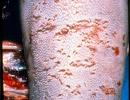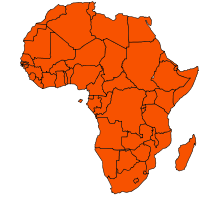
|
Mucosal disease
Local names:
Luo: diep nyaroya /
Kikuyu: ruharo rwa kimira /
Maasai: Iinkati /
Common names:
Bovine virus diarrhea
Description:
Management disease
|
Introduction
 |
| Geographical Distribution of Mucosal disease |
Mucosal Disease is caused by the same virus which causes Bovine Viral Diarrhoea. Both are manifestations of infection by the same virus. At one time it was thought that these were two separate diseases. Mucosal Disease refers to the condition in cattle persistently infected with noncytopathogenic BVD virus when they become superinfected with cytopathogenic virus and develop clinical disease. Incidence is low but mortality is high. The virus occurs all over the world and is probably more widespread than most people think, even in Kenya. Cattle that are persistently infected with noncytopathic Bovine Viral Diarrhoea Virus serve as a natural reservoir of virus. Transmission can occur post-natally by aerosol contact with infected secretions and excretions shed by persistently infected animals. Needle transmission can occur. Pre-natal persistent infection develops when noncytopathic virus is transmitted transplacentally during the first 4 months of foetal development. The calf is born infected and remains infected for life. Transplacental infection that occurs later in gestation results in abortion, congenital malformations, or birth of normal calves that have antibody against BVDV. So the outcome of infection varies according to the stage of pregnancy when infection occurs:
Up to 90 days of pregnancy
At this stage infected cows give birth to a calf with permanent infection of the disease and whose immune system does not recognize the virus as a foreign organism ("anti body negative calves"). Fifty percent of these calves develop clinical disease and die within the first two years of age from superinfection with a cytopathogenic strain of BVDV or by a mutation of the virus population within the animal itself. Calves appear to be stunted, and prone to respiratory and enteric ailments. In the infected mother foetal death and irregular returns to service occur.
90 to 180 days of pregnancy
Infection at this stage causes abortion or the birth of a congenitally deformed calf with perhaps eye and brain abnormalities or a persistently infected calf possibly with some antibody.
After 180 days of pregnancy
At this stage, the immune system of the foetus is fully developed and the immune system of the foetus detects and clears itself of infection. At birth such calves are normal and have antibodies against the disease. But abortion may still occur in the mother.
Whatever the stage of pregnancy the cow herself will often be only mildly affected - she may have a raised temperature and scour for a few days but only occasionally develops a severe illness. It is the persistently infected calf which causes problems.
Whatever the stage of pregnancy the cow herself will often be only mildly affected - she may have a raised temperature and scour for a few days but only occasionally develops a severe illness. It is the persistently infected calf which causes problems.
Signs of Mucosal disease
BVDV is immunosupressive and as as result an infected animal is much more susceptible to other infections such as those affecting the gut or lungs
The virus attacks all the mucosal surfaces in the body causing inflammation and ulceration and it is the results of this which cause the symptoms seen. Erosions can occur throughout the intestinal tract, lesions are seen in the mouth, nose and muzzle, there is often foul smelling diarrhoea containing shreds of intestine, mucus and blood. Occasionally diarrhoea may be so severe as to appear like water or paralysis of the gut may occur with no sign of faecal material. Other signs which may occur include discharges from the nose, excessive tears and lameness due to eruptive lesions of the interdigital cleft and coronary band. .Animals are reluctant to eat and there is drooling and even frothing from the mouth. High mortality with moderate morbidity is to be expected. In Mucosal Disease, where a persistently infected animal, usually under 2 years of age, is superinfected with internally acquired cytopathogenic virus, the mortality is very high, death occurring within a few days of onset, with fever, dysenteric diarrhoea, lack of appetite, dehydration, ulceration throughout the gastro-intestinal tract and erosive lesions in the mouth and nose.
The virus attacks all the mucosal surfaces in the body causing inflammation and ulceration and it is the results of this which cause the symptoms seen. Erosions can occur throughout the intestinal tract, lesions are seen in the mouth, nose and muzzle, there is often foul smelling diarrhoea containing shreds of intestine, mucus and blood. Occasionally diarrhoea may be so severe as to appear like water or paralysis of the gut may occur with no sign of faecal material. Other signs which may occur include discharges from the nose, excessive tears and lameness due to eruptive lesions of the interdigital cleft and coronary band. .Animals are reluctant to eat and there is drooling and even frothing from the mouth. High mortality with moderate morbidity is to be expected. In Mucosal Disease, where a persistently infected animal, usually under 2 years of age, is superinfected with internally acquired cytopathogenic virus, the mortality is very high, death occurring within a few days of onset, with fever, dysenteric diarrhoea, lack of appetite, dehydration, ulceration throughout the gastro-intestinal tract and erosive lesions in the mouth and nose.
Diagnosis is based on the disease history, clinical signs, gross and microscopic lesions, virus isolation from tissues such as spleen, thyroid and salivary gland and examination of paired serum samples when a more than four- fold increase in antibody titre indicates recent infection. Difficulties may occur when the presenting animal has no specific neutralising antibody due to immunesuppression or the inability to secrete antibody. So the whole picture must be considered.
The birth of congenitally abnormal calves, unexplained abortions, the appearance of stunted ill-thriven calves in the herd and cases of severe diarrhoea in young animals under the age of two years followed by their death must arouse a suspicion of BVD/ Mucosal Disease Complex. There will be a low incidence (5%) of acute clinical disease but a high case mortality. For diagnosis serum samples have to be sent to a laboratory outside of Kenya.
The birth of congenitally abnormal calves, unexplained abortions, the appearance of stunted ill-thriven calves in the herd and cases of severe diarrhoea in young animals under the age of two years followed by their death must arouse a suspicion of BVD/ Mucosal Disease Complex. There will be a low incidence (5%) of acute clinical disease but a high case mortality. For diagnosis serum samples have to be sent to a laboratory outside of Kenya.
Prevention - Control - Treatment
Treatment is limited to supportive therapy such as providing antibiotic cover to prevent secondary bacterial infections, appetite stimulants, vitamins and alimentary tract astringents, such as kaolin, charcoal etc.
Post-natally acquired BVD virus infections are trivial. Control measures therefore are directed to limiting the risk of transplacental infection. Persistently infected animals should be identified and removed and isolated from the breeding herd. Only virus-negative and antibody-positive animals should be retained in the herd. Live and killed vaccines have been developed. The former has several disadvantages such as the risk of transplacental infection, they are immunosuppressive and epidemics of the mucosal disease syndrome have been recorded after their use. Killed vaccines are safe, but booster doses are necessary to achieve a good level of protected immunity.
Because the disease mainly affects cattle under 2 years and since colostral immunity from BVD positive cows wanes by 6 months of age the vaccination of young stock between 6 months and 2 years of age is a logical approach, but the manufacturer's instructions should always be followed.
Vaccine is obtainable from the UK and the US.
Information Source Links
- Blowey, R.W. (1986). A Veterinary book for dairy farmers: Farming press limited Wharfedale road, Ipswich, Suffolk IPI 4LG
- Barber, J., Wood, D.J. (1976) Livestock management for East Africa: Edwar Arnold (Publishers) Ltd 25 Hill Street London WIX 8LL
- Force, B. (1999). Where there is no Vet. CTA, Wageningen, The Netherlands. ISBN 978-0333-58899-4.
- Pagot, J. (1992). Animal Production in the Tropics and Subtropics. MacMillan Education Limited London
- Hunter, A. (1996). Animal health: General principles. Volume 1(Tropical Agriculturalist) - Macmillan Education Press. ISBN: 0333612027
- Hunter, A. (1996). Animal health: Specific Diseases. Volume 2(Tropical Agriculturalist) - Macmillan Education Press. ISBN:0-333-57360-9
- Blood, D.C., Radostits, O.M. and Henderson, J.A. (1983) Veterinary Medicine - A textbook of the Diseases of Cattle, Sheep, Goats and Horses. Sixth Edition - Bailliere Tindall London. ISBN: 0702012866
- Hall, H.T.B. (1985). Diseases and parasites of Livestock in the tropics. Second Edition. Longman Group UK. ISBN 0582775140
- ITDG and IIRR (1996). Ethnoveterinary medicine in Kenya: A field manual of traditional animal health care practices. Intermediate Technology Development Group and International Institute of Rural Reconstruction, Nairobi, Kenya. ISBN 9966-9606-2-7.
- The Organic Farmer magazine No. 50 July 2009

 Back
Back
